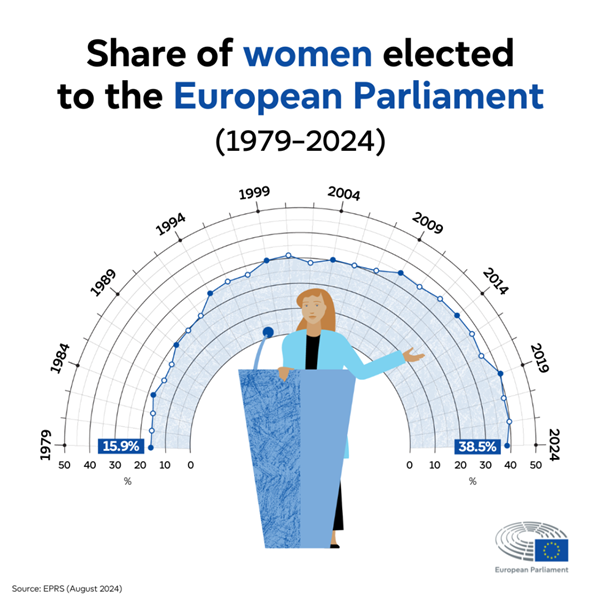One of the highlights of the current term of the European Parliament has been Ursula von der Leyen’s Commission’s activity on equality, diversity and inclusion. During the last 4,5 years, Commission has launched numerous legislative proposals regarding equality, rule of law and promotion of human rights.
This Commission has also unblocked legislation on the area, for example the so-called ”Women on Boards” Directive that was blocked for 10 years. Right now, the EU is negotiating on its first ever legislation against violence against women: Combatting Violence against Women Directive.
Other examples of EU legislation and Commission communications on equality are Citizens, Equality, Rights and Values Programme, launch of the European Disability Card, Equality Bodies Directives and the European Care Strategy.
This development is much needed: anti-gender movement is thriving globally, including in Europe and in the EU, and we need to fight against it. Rule of law and human rights breaches need to be acknowledged, even when other crisis are unfolding in Europe.
Cooperation contributes to the development of EDI themes
The role of gender mainstreaming and gender budgeting has also considerably strengthened during the last couple of years in the work of the EU, both when preparing and implementing legislation. This is much thanks to the important work of the European Institute for Gender Equality EIGE and their Annual Gender Equality Index that measures the realisation of equality across the European Union.
In the European Parliament, women’s rights and equality committee FEMM, of which I am a member, focuses particularly on EDI topics. However, gender and equality mainstreaming should be in place in all committees of the Parliament.
When it comes to the functioning of the European Parliament, internal mechanisms are in place to ensure equality in decision-making: available translation, information in different formats, anti-harassment trainings and whistle-blower systems.
Nevertheless, we are not done with equality: in the EU, we urgently need a horizontal anti-discrimination directive to cover all grounds of discrimination and to allow for more effective anti-discrimination legislation. European Commission presented its proposal on this already in 2008, but the Council has not reached unanimity and the draft legislation has remained blocked for 15 years. Parliament has repeatedly called for the Council to unblock and advance the proposal. The directive would allow the implementation of principle of equal treatment horizontally outside the labour market, irrespective of age, disability, sexual orientation or religious belief.
During this mandate, one of the most prominent pieces of equality legislation has been the Directive on Pay Transparency that entered into force this year. Member States now have three years to transpose the directive and make the necessary legislative changes.
Transparency and gender-neutral criteria on wages
The directive ensures that women and men are paid the same for the same work or work of equal value, based on gender-neutral criteria. It applies to both public and private employers and improves the worker’s position by adding to the transparency of pay, already during the recruitment procedure, and giving the right to obtain information on the salaries and pay level of the workplace, regardless of the size of the employer. Employees can ask about salary levels once they suspect they have been a victim of wage discrimination.
The directive’s reporting obligations will eventually apply to all companies with at least 100 employees. Smaller companies are encouraged to report voluntarily. If the unexplained gender pay gap reported by the company is more than 5 percent, the company must take action and implement a joint pay assessment to close the pay gap.
The directive also allows for systematic methodology for evaluating salaries, including cross-sector comparisons and a so-called hypothetical comparator that can be used if a benchmark for men’s salaries is not available for example in a female-dominated field. Intersectional discrimination is included in the directive as an aggravating element if discrimination has occurred on grounds also other than gender.
The ways of implementing the directive vary between Member States as different kinds of legislation and requirements are in place currently in different Member States. All the Member States must communicate to the Commission eight years after the entry into force of the directive all information on how the directive has been applied and what has been its impact in practice. In Finland, our legislation already meets the majority of the requirements of the Pay Transparency Directive, but hopefully it speeds forward the review of the Finnish Equality between Women and Men Act (from 1995), the review of which was last suspended in 2022.
More work and legislation still needed
The upcoming directives on the standards for equality bodies are extremely important for the actual implementation of equality legislation and the Pay Transparency Directive. Equality bodies are the instances that detect discrimination and help and assist victims, and they need to have the necessary tools to do so. If not, the excellent equality legislation, such as Pay Transparency Directive, cannot be adequately implemented. The work on the Equality Bodies directives is ongoing and the aim is to finalize them during this mandate before the European elections in June. Work on equality is not done!

Author: MEP Sirpa Pietikäinen, is a Finnish Member of the European Parliament representing the European People’s Party (EPP) since 2008. She was Finland’s Minister of Environment from 1991 to 1995 and a Member of the Finnish Parliament from 1983 to 2003.
Picture: Sami Kero






